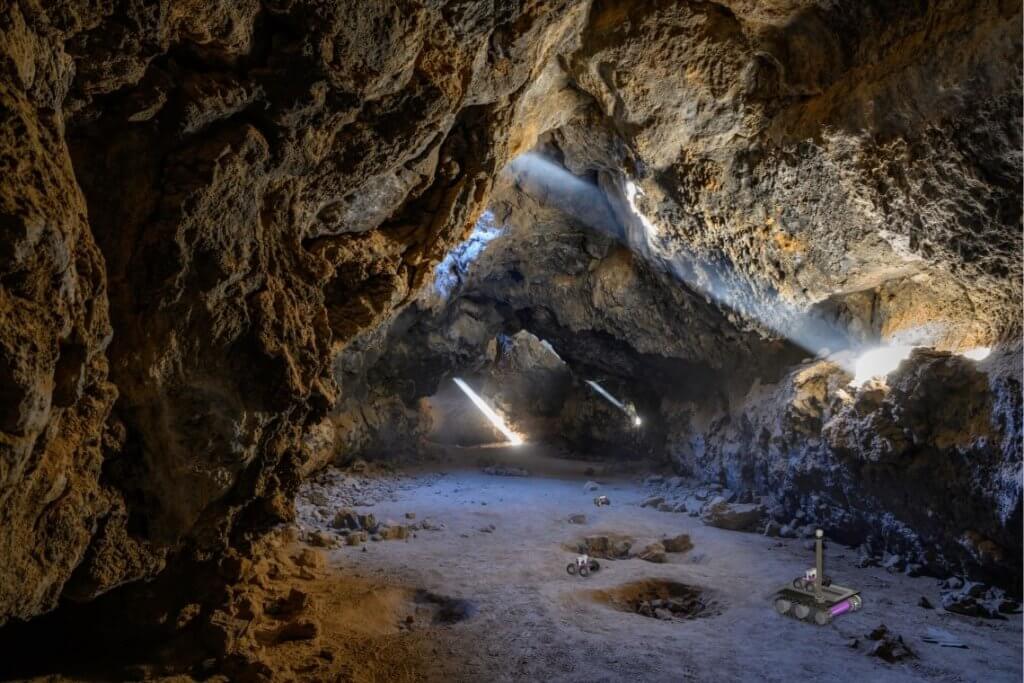
Mars cave-exploring robots take inspiration from Hansel and Gretel’s breadcrumb trick (Image Credit: Space.com)
Newly proposed Mars exploration rovers have a peculiar inspiration, the classic Grimm Brothers’ fairy tale Hansel and Gretel.
The flock of robots will follow “breadcrumbs” to find their way out of caves just as the eponymous siblings attempted to escape the forest in which they were abandoned by their parents in the famous fairytale.
The breadcrumbs-following flock of robots devised by researchers at the University of Arizona (UArizona) College of Engineering could explore subsurface regions on Mars including caves and lava vents. This exploration could help scout out locations that could go on to be used by astronauts stationed on the Red Planet for long-term missions.
The flock of robots, which could also include lake landers and submersible vehicles, for use on ocean worlds, would be linked by a communications network allowing them to work independently or as a team, all without direction from humans.
Related: Space station experiment suggests Mars rovers will need to dig deep to find life
“If you remember the book, you know how Hansel and Gretel dropped breadcrumbs to make sure they’d find their way back,” Wolfgang Fink, an associate professor of electrical and computer engineering at UArizona and lead author of the concept, said in a statement (opens in new tab). “In our scenario, the ‘breadcrumbs’ are miniaturized sensors that piggyback on the rovers, which deploy the sensors as they traverse a cave or other subsurface environment.”
These “breadcrumbs” or communication nodes that the robots drop as they cross the alien vistas mean the rovers can proceed on their own, connected to each other wirelessly as they explore different environments. They can simultaneously maintain awareness of their location by continuing to drop high-tech sensor “breadcrumbs” along the way. The release of a node would come regardless of how much distance the robot has traveled since dropping its last breadcrumb, as the subsequent release is triggered by the rover recognizing a signal within range but fading.
“One of the new aspects is what we call opportunistic deployment — the idea that you deploy the ‘breadcrumbs’ when you have to and not according to a previously planned schedule,” Fink said.
Keeping in touch with mother
The robot flock would have a mother unit, and while input from this commanding unit won’t be needed, a subordinate unit in the flock could determine if it needs guidance. As a result, Fink points out, this system, fittingly named the Breadcrumb-Style Dynamically Deployed Communication Network paradigm (DDCN), can function in two ways. A passive mother unit can collect information at the surface while its offspring explore the underground, or the mother unit can directly control operations and the rovers’ movements more directly.
The Hansel and Gretal-inspired system could overcome one of the major challenges associated with sending autonomous units to explore the subsurface of alien worlds — the recovery of data the rovers collect, and getting it back to the surface. The DDCN enables constant data transmission as each robot in the flock stays in touch with “mother” even in convoluted and complex environments.
The exploration capability of these robots could be further boosted by outfitting each unit with a light detection and ranging system, or lidar, that would allow the robots to map out cave systems in 3D and create a network the entire flock could use.
“They can switch between each other and compensate for dead spots and signal blackouts,” research co-author and senior research scientist in Fink’s laboratory, Mark Tarbell, said. “If some of them die, there still is connectivity through the remaining nodes, so the mother rover never loses connection to the farthest node in the network.”
Just because the network of communication nodes ensures data makes it back to the mother unit and thus to the surface of alien worlds, that doesn’t mean the individual units have to. Just like Hansel and Gretal’s cruel parents, the robotic mother can abandon its offspring, but in alien tunnels rather than in a foreboding forest.
“They’re designed to be expendable,” Fink added. “Instead of wasting resources to get them into the cave and back out, it makes more sense to have them go as far as they possibly can and leave them behind once they have fulfilled their mission, run out of power, or succumbed to a hostile environment.”
The usage of the system goes beyond the exploration of caves, however, DDCN could also be used to investigate subsurface oceans such as those that are believed to exist beneath the ice shell of Jupiter‘s moon Europa. Or the robot flock could dive into the lakes of Saturn‘s moon Titan which sit under a thick atmosphere. In these situations the communication nodes would act as repeaters, boosting the signals at regular intervals, thus preventing that signal from degrading.
Additionally, Fink added that the nodes have the ability to gather data, not just relay it. This means that in liquid environments on worlds like Europa, they could measure qualities like pressure, salinity, temperature, and other chemical and physical parameters sending this via a connecting cable back to a lander unit.
“Imagine you make it all the way to Europa, you melt your way through miles of ice, make it down to the subsurface ocean, where you find yourself surrounded by alien life, but you have no way of getting data back to the surface,” he said. “That’s the scenario we need to avoid.”
With the robot units and its communication network developed, Fink and the team will now set about building the actual deployment unit that can drop the communication nodes.
“Basically, we’re going to teach our ‘Hansels’ and ‘Gretels’ how to drop the breadcrumbs so they add up to a functioning mesh communication network,” Fink said.
The team’s research is published in the journal Advances in Space Research. (opens in new tab)
Follow us on Twitter @Spacedotcom (opens in new tab) or on Facebook (opens in new tab).








